
There are folks who feed the birds, and then there are folks who feed hummingbirds.
I know quite a few people who have hummingbird feeders but not seed feeders. That’s because hummingbirds are in a class of their own. They are immensely fascinating to watch, with such big personalities packed into tiny bejeweled bodies.
So, it’s kind of a bummer when you go to all the trouble to set up feeders, and there aren’t any hummingbirds visiting.

Not to worry, there are some pretty common (and easy to fix) reasons why hummingbirds might not be sipping sugar water at your feeder yet.
1. Only Using One Feeder

Hummingbirds are incredibly territorial. It’s not uncommon for one male to hang out near a feeder and chase off smaller birds. To that end, it’s always better to have more than one hummingbird feeder. Two is better than one, and three is even better.
2. Too Close to Another Feeder
But when you hang up your feeders, you need to spread them out to prevent tiny-winged tyrants from staking out all of them. A good rule of thumb is to set up feeders out of sight of each other. By keeping them apart, you allow more hummingbirds the chance to visit.
3. Moving the Feeder Too Often
I get it; you want to make sure your feeder is where the birds will find it, and it can be frustrating when none show up. However, moving the feeder only makes it harder for hummingbirds to find and use it. Choose a spot and stick with it. Be patient, and in time, the hummingbirds will find it.
In the meantime, keep replacing the sugar water and keep the feeder clean. This will ensure that when the birds do find your feeder, they will keep coming back.
4. Nowhere to Perch
Hummingbirds enjoy a good sit down like the rest of us. It’s not surprising, considering how much energy goes into keeping them alight. But when they need a break, hummingbirds need a perch. Unlike many birds that will land on the ground, hummingbirds will only perch somewhere up off the ground. (They can’t hop.)

Some hummingbird feeders have perches, and some do not, so that’s fine. It’s more important to hang the feeders near a tree or shrubs so they can rest away from the feeder.
If you don’t have a tree or shrubs nearby, consider making a few hummingbird perches and hanging them a yard or two away from the feeders.
5. Feeder is Left Empty Too Often

This one is pretty self-explanatory. Birds won’t stick around if a bird feeder isn’t replenished when they’ve drunk all the sugar water. If you let your hummingbird feeder remain empty for days at a time, they’ll move on to a more consistent resource.
6. Your Feeder is Not High Enough Off the Ground

Because hummingbirds make easy targets for cats and other predators, they prefer to stick to higher ground. Setting a feeder up that’s too low will ensure birds won’t use it. Hummingbird feeders should be about five to six feet up off the ground. If your feeder is out in the open, away from shrubbery or trees, this is even more important.
7. The Feeder is Dirty

Keeping hummingbird feeders clean is important because it can prevent illness and disease. Because you’re hanging sugar water out in a warm, sunny atmosphere, it’s only a matter of time before bacteria and mold begin to grow.
Change your nectar solution if you notice that it’s cloudy, has a film across the top or black specks have started to develop inside the feeder or around the flowers. In especially warm weather, you’ll need to change out your nectar more often.
My sweetie is a big hummingbird lover, and he makes up a large batch of nectar and keeps it in the fridge, preferring to fill his feeders only a third or halfway (and more frequently) during the hottest days of the summer. This way, the birds go through it before it has a chance to spoil.

Washing your feeder is just as important as changing out the sugar water. Clean your feeders once a week or as soon as you notice signs of mold. Most of them are easy to clean these days and can be taken apart and put in the dishwasher. Some even come with tiny bristle-brushes to clean the flower ports.
If you’re hand washing your feeder, opt for a bleach and water solution rather than soap.
8. Not Enough Red

Usually, this is a problem you only have if you’re starting to feed hummingbirds. Once the birds know there is a steady supply of sugar water at your place, they’ll return year after year. But if you don’t have an established feeder, you might want the help of a bit more red nearby to bring them in.
Consider planting red flowers near your feeder. Scarlet bee balm is an excellent choice for attracting hummingbirds. This beautiful perennial will spread, offering tall, stately blooms that hummingbirds love. Beyond hummingbirds, there are a lot of great reasons to grow bee balm.
No Red Here, Please

One area where you absolutely don’t need red is in the sugar water. First of all, don’t waste your money on all the fancy nectar solutions they sell in the stores. They’re over-priced, and the added red food coloring isn’t good for the hummingbirds. A simple sugar water solution of one part sugar to four parts water is all that’s needed. Along with red food coloring, you should never use honey or brown sugar.
9. Nesting Season

You saw that first hummingbird and got your feeder out. But since you’ve set it up, there isn’t a single hummingbird to be found. One reason hummingbirds may not frequent your feeder for a while is because it’s nesting season.
Hummingbirds mate during the spring, shortly after their return.
But because they’re so territorial, it’s not uncommon for a single male to keep other male hummingbirds away during the nesting period. Have patience, and once the chicks leave the nest (usually in late June/early July), you’ll see these pretty jeweled flyers at your feeder once again.

It can be frustrating cleaning and maintaining a hummingbird feeder that no one is using, but if you keep at it and use this list, eventually, they will show up.
Read Next:

Get the famous Rural Sprout newsletter delivered to your inbox.
Including Sunday musings from our editor, Tracey, as well as “What’s Up Wednesday” our roundup of what’s in season and new article updates and alerts.



